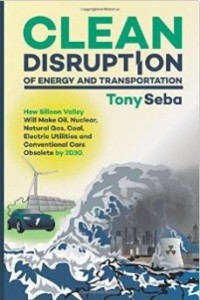 As covered last week, AltCar Expo keynote speaker Tony Seba made some outrageous statements about the future of transportation technology and economics. The Silicon Valley entrepreneur and Stanford University lecturer inspired humorous comments from panel speakers, and interesting conversations for attendees who had just heard him speak – inspiring for those supporting electrified transportation and solar power and ominous for those making their living in automotive, transportation, and other industries. A question that stuck in my mind: What will Ford Motor Co., Hertz, Mack Trucks, Manheim, and mega-dealers be selling 25 years from now?
As covered last week, AltCar Expo keynote speaker Tony Seba made some outrageous statements about the future of transportation technology and economics. The Silicon Valley entrepreneur and Stanford University lecturer inspired humorous comments from panel speakers, and interesting conversations for attendees who had just heard him speak – inspiring for those supporting electrified transportation and solar power and ominous for those making their living in automotive, transportation, and other industries. A question that stuck in my mind: What will Ford Motor Co., Hertz, Mack Trucks, Manheim, and mega-dealers be selling 25 years from now?
The statistics and market analysis presented by Seba were fascinating. They came from his recently published book, Clean Disruption of Energy and Transportation: How Silicon Valley Will Make Oil, Nuclear, Natural Gas, Coal, Electric Utilities and Conventional Cars Obsolete by 2030. Here are a few points he made……
- The auto industry played an integral role in the development of “disruptive technology.” One interesting point was seeing photos of a street in New York City in 1900 and then in 1913 – with one car featured in 1900 and the street filled with them 13 years later. Seba thinks we’re full bore into another disruption cycle that will radically alter the products and services offered in automotive and transportation.
- Lithium batteries are going down 14% in cost per year, and that’s expected to continue for the foreseeable future. Tesla Motor’s “gigafactory,” once it’s up and running, will be able to double the word’s supply of these batteries and will bring their prices down even further.
- By 2018, automakers will be offering $40,000 battery electric vehicles (EVs) that can get 200 miles per charge. Disruption will continue – by 2020, that price will drop to $31,000 and its range will be comparable to, or better than, internal combustion engine (ICE) powered cars. By 2023, average EV prices will go down to $21,000. He says that by 2030, all mainstream cars will be electric and ICEs will be obsolete.
- As for autonomous cars, disruptive technology will see a big price drop and become economically viable for the future of transportation. In 2012, a LIDAR (light radar) system cost $70,000 for a test self-driving car. That now costs $10,000 per driverless car. As for what consumers think about it, a recent Cisco Systems survey found that 95% of Brazilians are willing right now to use a self-driving car, and 60% of Americans are willing to do the same.
- Autonomous vehicles, along with carsharing services like Zipcar and ridesharing services like Uber, will be game changers. Annual sales of new vehicles will shrink, highways will open up, and many of the parking spaces we have in our cities will go away. Highway capacity can be increased four times when autonomous vehicles show up on our roads; there will be no need for 80% of our parking spaces as autonomous vehicles show up exactly when and where they’re needed by the owner. The insurance industry will also take a big hit as the need for car insurance will diminish.
- As for solar power, installation of solar panels has been increasing 43% per year worldwide since 2000. If this continues, all of the world’s energy will be solar by 2030, he says.
- When the question of hydrogen fuel cell vehicles came up, Seba made comments that obviously didn’t go over too well with hydrogen advocates. Hydrogen is not a disruptive technology and works much the same way as gasoline in production and pipeline/trucking distribution. EVs are three-to-four times more energy efficient than hydrogen.
Seba may be way too off the mark on several of his conclusions, but he’s right about one thing: technology and economics are going through a historic shift right now. The role of automakers and transportation companies is changing – which is why we’re seeing automakers startup car sharing services and test out self-driving cars. It’s also a driving force behind nearly every automaker rolling out an EV and other alternative fuel vehicles.
Clean transportation has a very important role to play. It’s providing a channel for advanced vehicle technologies, reducing emissions and fuel consumption, and supporting economic advancement and job creation in a fast-changing world. Maybe you’ll get laid off by an automaker and go to work for a specialty EV maker, or lithium battery maker, or alternative fuel infrastructure supplier, or an advanced engineering and design firm. That sounds much better than taking drive-through orders at McDonalds. As my grandfather used to say, “Always be looking for another job.”




“autonomous vehicles show up exactly when and where they’re needed by the owner”. Change “owner” to “user” and you have got it right. Individual ownership of cars will decline as people see the economic advantage of hiring self-driving cars by the minute, hour or distance traveled, instead of paying for a private car to sit unused in a driveway like mine is right now.